INVENTORY OF GAMES
THE "CORAL" COLLECTION
Playing Cards of the 20th Century (1880-2020)
© CeDIG.org (Switzerland)
LAST UPGRADE: 02.07.2024 | LAST ENTRY: INV 2721
This is the catalogue of the «Coral» division, dedicated to playing cards owned and preserved in the archives of the Documentation Center [CeDIG], as well as the first section, fully illustrated, of the games inventory [IGLOO]. It contains major playing cards of the 20th century (actually 1880-2020, occasionally extended), European style.
The collection has achieved its objective1), namely the acquisition of a sufficiently representative and proportionate heritage, adhering to historical reality in terms of production, circulation, places and times. All European countries are represented2), as well as other selected places that have taken up the tradition.
The main purpose of this systematic catalogue3) is the visualisation of preserved heritage for the benefit of all interested parties.
A significant selection of cards has been added to the primary purpose, in order to explore the vastness of the field and observe its types and styles, and, thanks to the comparative method of visualisation, to scrutinise similarities and differences. Furthermore, to enable identification, all decks contain at least one «key card»: for Italian and Spanish suits the King of Swords, for German and Swiss suits the Ober of Acorns, for French suits the King of Hearts. Thus it is possible, with a little patience, to trace the deck to which the cards belong (if in the catalogue). Finally, all cards are represented in the same scale, so that the correct proportions are immediately perceived.
_______________
1)Additions, however, remain possible. 2)Only Albania and most of the republics that emerged after the dissolution of Yugoslavia are missing, due to absent or insignificant production. 3)Each deck is placed in only one position. See further notes at the bottom of the page.
The collection has achieved its objective1), namely the acquisition of a sufficiently representative and proportionate heritage, adhering to historical reality in terms of production, circulation, places and times. All European countries are represented2), as well as other selected places that have taken up the tradition.
The main purpose of this systematic catalogue3) is the visualisation of preserved heritage for the benefit of all interested parties.
A significant selection of cards has been added to the primary purpose, in order to explore the vastness of the field and observe its types and styles, and, thanks to the comparative method of visualisation, to scrutinise similarities and differences. Furthermore, to enable identification, all decks contain at least one «key card»: for Italian and Spanish suits the King of Swords, for German and Swiss suits the Ober of Acorns, for French suits the King of Hearts. Thus it is possible, with a little patience, to trace the deck to which the cards belong (if in the catalogue). Finally, all cards are represented in the same scale, so that the correct proportions are immediately perceived.
_______________
1)Additions, however, remain possible. 2)Only Albania and most of the republics that emerged after the dissolution of Yugoslavia are missing, due to absent or insignificant production. 3)Each deck is placed in only one position. See further notes at the bottom of the page.
FEATURED DECK:
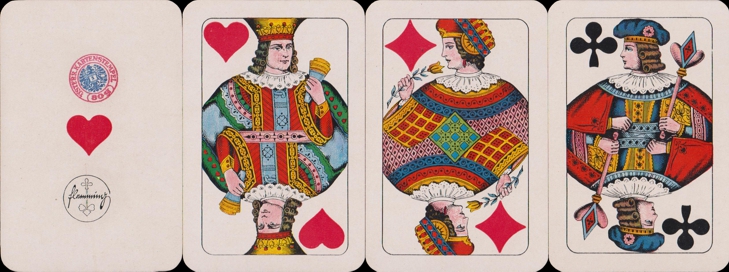

German deck, c1926 ➽ FR/Viennese pattern
WHAT'S NEW:
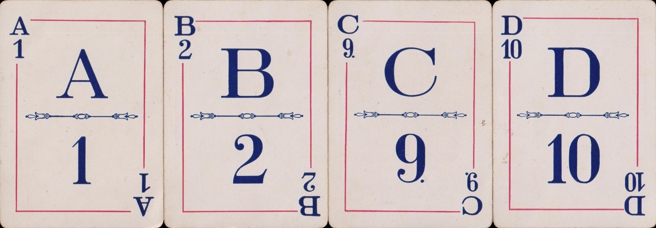
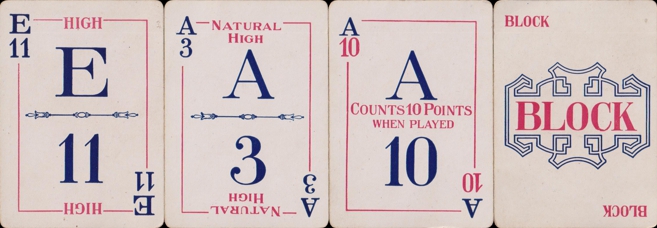
Card game, c1905 ➽ MX/Letter systems
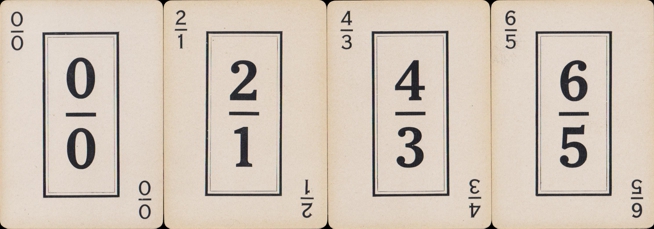
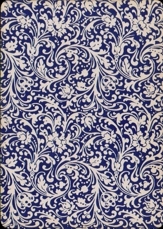
Card/Domino game, c1930 ➽ MX/Dominoes/European style

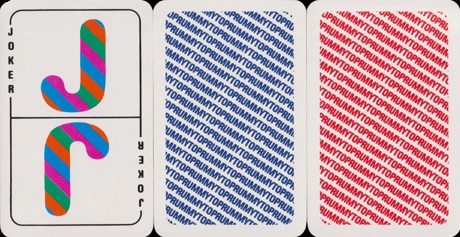
Card game, c1980? ➽ MX/Colour systems
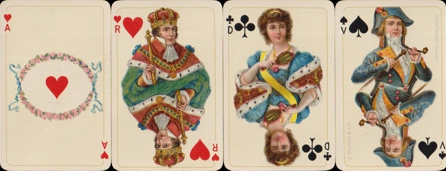

Swiss deck, c1900 ➽ FR/Switzerland
ITALIAN SUIT SYSTEM — Main conventional patterns
single-headed
double-headed
pattern name

Venetian pattern
Also known as Treviso pattern.
Forefather of the entire system.
Venetian pattern [19]
Also known as Treviso pattern.
Forefather of the entire system.
Venetian pattern [19]






«Primiera bolognese» pattern
It shares style and designs with the Bolognese tarot pattern.
Suits of cups and coins are more reminiscent of Italo-Spanish styles.
"Primiera Bolognese" pattern [5]
It shares style and designs with the Bolognese tarot pattern.
Suits of cups and coins are more reminiscent of Italo-Spanish styles.
"Primiera Bolognese" pattern [5]

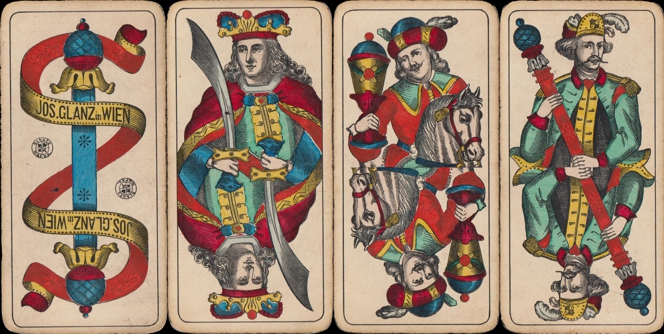
«Trappola» patterns
This type of deck spread mainly in Austria, Bohemia and Silesia.
Often with large Tarot-like cards.
"Trappola" patterns [8]
This type of deck spread mainly in Austria, Bohemia and Silesia.
Often with large Tarot-like cards.
"Trappola" patterns [8]
Conventional tarot patterns
court cards
trump suit
pattern name


Bolognese tarot pattern
It shares style and designs with the «Primiera Bolognese» pattern.
Bolognese tarot pattern [4]
It shares style and designs with the «Primiera Bolognese» pattern.
Bolognese tarot pattern [4]


Florentine tarot pattern
Also known as «Minchiate», «Gèrmini» and many more.
Florentine tarot pattern [5]
Also known as «Minchiate», «Gèrmini» and many more.
Florentine tarot pattern [5]


Minor conventional patterns
single-headed
double-headed
pattern name

All other decks
HYBRID SUIT SYSTEM — Conventional tarot patterns
Spanish suits for aces (A) and court cards (KQCJ) and Italian suits for number cards (2-10).
court cards
trump suit
pattern name




SPANISH SUIT SYSTEM — Main conventional patterns
single-headed
double-headed
pattern name





Castilian pattern
Also known as (generic) Spanish pattern.
Castilian pattern [29] | Variants & alternative versions [15]
Also known as (generic) Spanish pattern.
Castilian pattern [29] | Variants & alternative versions [15]











Naples pattern
Formerly also known as Bari pattern.
Leading member of Southern-Italy card family.
Naples pattern [18]
Formerly also known as Bari pattern.
Leading member of Southern-Italy card family.
Naples pattern [18]

Conventional tarot patterns
court cards
trump suit
pattern name


Minor conventional patterns
single-headed
double-headed
pattern name


Portuguese patterns
Also known, because of the aces, as «Dragon» pattern.
A later exogenous version elevated the female rank to "queen".
Portuguese patterns [4]
Also known, because of the aces, as «Dragon» pattern.
A later exogenous version elevated the female rank to "queen".
Portuguese patterns [4]





Abruzzo pattern
Attempt (on a Neapolitan basis) to establish a new pattern for the region.
Abruzzo pattern [1]
Attempt (on a Neapolitan basis) to establish a new pattern for the region.
Abruzzo pattern [1]

Salento pattern
Attempt (on a Neapolitan basis) to establish a new pattern for the region.
Salento pattern [1]
Attempt (on a Neapolitan basis) to establish a new pattern for the region.
Salento pattern [1]
All other decks
sample
sample
country (A-Z)



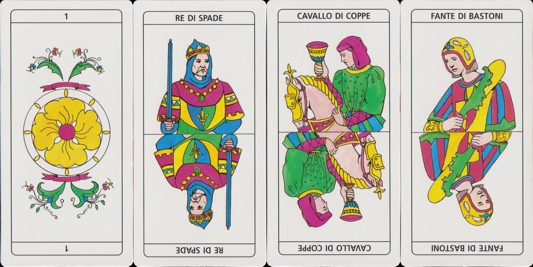



Spain
With suit variations, as long as the membership remains recognisable.
Spain [34] | Fournier [18] | Reproductions [14]
With suit variations, as long as the membership remains recognisable.
Spain [34] | Fournier [18] | Reproductions [14]
GERMAN SUIT SYSTEM — Main conventional patterns
single-headed
double-headed
pattern name







Bavarian patterns
Bavarian super-family, with piper and drummer.
Two main styles and several variants.
Bavarian patterns [29]
Bavarian super-family, with piper and drummer.
Two main styles and several variants.
Bavarian patterns [29]

Salzburg pattern
Variant of the Bavarian pattern.
Also, here, a variant of the Tyrolean pattern.
Salzburg pattern [9]
Variant of the Bavarian pattern.
Also, here, a variant of the Tyrolean pattern.
Salzburg pattern [9]



Bohemian pattern
Member of the Bavarian super-family.
Also known as Prague pattern.
Bohemian pattern [9]
Member of the Bavarian super-family.
Also known as Prague pattern.
Bohemian pattern [9]


Prussian pattern
Formerly, in DDR/GDR times, also known as Halle pattern.
Includes the Silesian-Polish variant.
Prussian pattern [32]
Formerly, in DDR/GDR times, also known as Halle pattern.
Includes the Silesian-Polish variant.
Prussian pattern [32]

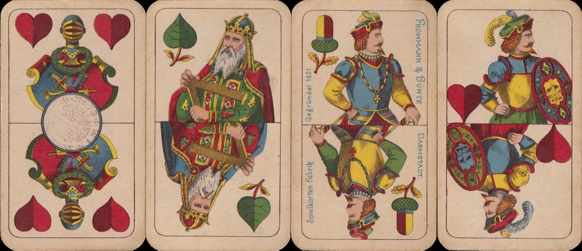


«Tell» patterns
The Swiss hero for the last Hungarian pattern.
Also described as «Four Seasons» pattern.
"Tell" patterns [19]
The Swiss hero for the last Hungarian pattern.
Also described as «Four Seasons» pattern.
"Tell" patterns [19]


New Altenburg pattern
Also known as DDR pattern (DDR=GDR or "East Germany").
One style but three main variants.
New Altenburg pattern [10]
Also known as DDR pattern (DDR=GDR or "East Germany").
One style but three main variants.
New Altenburg pattern [10]
Minor conventional patterns
single-headed
double-headed
pattern name



Oedenburg pattern
Oedenburg, or Sopron (in hungarian), a town on the border of the two states.
Oedenburg/Sopron pattern [1]
Oedenburg, or Sopron (in hungarian), a town on the border of the two states.
Oedenburg/Sopron pattern [1]

Eger/Luditz pattern
Eger and Luditz, two towns in the Sudeten region of Bohemia.
Eger/Luditz pattern [1]
Eger and Luditz, two towns in the Sudeten region of Bohemia.
Eger/Luditz pattern [1]

All other decks
sample
sample
country (A-Z)



BOHEMIA-MORAVIA
The area of today's Czech Republic after independence from Austria (1918).
Bohemia-Moravia [7]
The area of today's Czech Republic after independence from Austria (1918).
Bohemia-Moravia [7]






SWISS SUIT SYSTEM — Conventional pattern
single-headed
double-headed
pattern name


All other decks
sample
sample
country (A-Z)




FRENCH SUIT SYSTEM — Main conventional patterns
single-headed
double-headed
pattern name

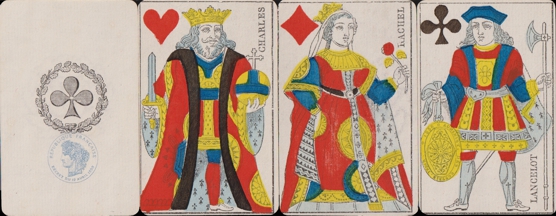


French international pattern
Also known as Belgian or Genoa pattern.
France, Belgium & other countries [34] | Italy (Genoese pattern) [14]
Also known as Belgian or Genoa pattern.
France, Belgium & other countries [34] | Italy (Genoese pattern) [14]

Piedmont pattern
Cards of the French double-headed pattern, horizontally divided.
Piedmontese pattern & others [12]
Cards of the French double-headed pattern, horizontally divided.
Piedmontese pattern & others [12]







Vienna patterns
Lyon export pattern.
It gave rise to several Viennese patterns.
Viennese patterns [29]
Lyon export pattern.
It gave rise to several Viennese patterns.
Viennese patterns [29]


Belgian patterns
Belgian «cartes marbrées» (large) & Brussels «cartes étroites» (narrow).
Belgian & Brussels patterns [6]
Belgian «cartes marbrées» (large) & Brussels «cartes étroites» (narrow).
Belgian & Brussels patterns [6]



Rouen pattern
The origin of the modern English pattern.
Here restored decks and modern derivations.
Rouen pattern [4]
The origin of the modern English pattern.
Here restored decks and modern derivations.
Rouen pattern [4]


English pattern
UK 1 [27] | UK 2 [19] | Belgium [11] | Germany [13] | Italy [16] | Austria [12] | Europe (others) [33] | USA 1 [36] | USA 2 [26] | USPC [34] | Others [9] | Indices [12] | New suits [17] | Colours [19] | Shapes [11] | Sizes [18]
UK 1 [27] | UK 2 [19] | Belgium [11] | Germany [13] | Italy [16] | Austria [12] | Europe (others) [33] | USA 1 [36] | USA 2 [26] | USPC [34] | Others [9] | Indices [12] | New suits [17] | Colours [19] | Shapes [11] | Sizes [18]





«Trente-et-Quarante» pattern
A specific pattern for use in (some) European casinos.
"Trente-et-Quarante" pattern [7]
A specific pattern for use in (some) European casinos.
"Trente-et-Quarante" pattern [7]

Frankfurt patterns
Several Frankfurt patterns & similar «cartes belges» pattern.
Still produced in the «Adler-Cego» (tarot) format.
"Cartes Belges" & Frankfurt patterns [16]
Several Frankfurt patterns & similar «cartes belges» pattern.
Still produced in the «Adler-Cego» (tarot) format.
"Cartes Belges" & Frankfurt patterns [16]

Rheineland pattern
A Dondorf house pattern that has spread internationally.
Rheineland (or Dondorf) pattern [32]
A Dondorf house pattern that has spread internationally.
Rheineland (or Dondorf) pattern [32]


Milan pattern
With clear traces of its lineage in the Lyon pattern.
Cards with rank names & indices are mainly for Switzerland (Ticino).
Milanese pattern [22]
With clear traces of its lineage in the Lyon pattern.
Cards with rank names & indices are mainly for Switzerland (Ticino).
Milanese pattern [22]


Florentine pattern
Formerly also described as "large" Florentine (or Tuscan) pattern.
Today, with its smaller format, it is better known as (new) Tuscan pattern.
Florentine (& new Tuscan) pattern [15]
Formerly also described as "large" Florentine (or Tuscan) pattern.
Today, with its smaller format, it is better known as (new) Tuscan pattern.
Florentine (& new Tuscan) pattern [15]




Conventional tarot patterns
court cards
trump suit
pattern name


«Adler-Cego» tarot pattern
The court cards come from a Frankfurt pattern.
Here, furthermore, other tarots with animals.
"Adler-Cego" and others [4]
The court cards come from a Frankfurt pattern.
Here, furthermore, other tarots with animals.
"Adler-Cego" and others [4]




«Bourgeois» tarot pattern
Also known as Tarot «nouveau» and «encyclopédique».
In Germany also «Cego».
"Bourgeois" tarot pattern [18]
Also known as Tarot «nouveau» and «encyclopédique».
In Germany also «Cego».
"Bourgeois" tarot pattern [18]
Minor conventional patterns
single-headed
double-headed
pattern name


«cartes italiennes» pattern
Conventional name.
Also named after the images on the aces.
"Cartes Italiennes" pattern [3]
Conventional name.
Also named after the images on the aces.
"Cartes Italiennes" pattern [3]
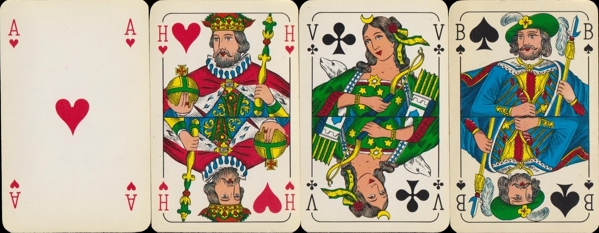
«cartes suisses» pattern
Conventional name.
Also named after the images on the aces.
"Cartes Suisses" pattern [3]
Conventional name.
Also named after the images on the aces.
"Cartes Suisses" pattern [3]

«cartes imperiales» patterns
Mostly a Belgian/Dutch pattern, in two main versions.
"Cartes Imperiales" patterns [13]
Mostly a Belgian/Dutch pattern, in two main versions.
"Cartes Imperiales" patterns [13]








«Cartes Parisiennes» pattern
In the "Royal" version, the Queen of Hearts has no feathered hat.
"Cartes Royales" & "Cartes Parisiennes" patterns [4]
In the "Royal" version, the Queen of Hearts has no feathered hat.
"Cartes Royales" & "Cartes Parisiennes" patterns [4]




«Salon-karte» pattern
"Salonkarte" is often equivalent (as in this case) to 'deluxe cards'.
"Salon-Karte" pattern [5]
"Salonkarte" is often equivalent (as in this case) to 'deluxe cards'.
"Salon-Karte" pattern [5]
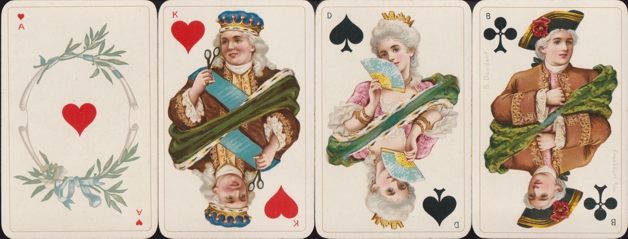
«Baronesse» pattern
Prototype of modern Rococo-style cards.
And also directly inspired designs.
"Baronesse" pattern [14]
Prototype of modern Rococo-style cards.
And also directly inspired designs.
"Baronesse" pattern [14]

«Mittelalter-karte» pattern
Has become almost a standard pattern in Portugal.
Here also directly derived designs.
"Mittelalter-Karte" pattern [6]
Has become almost a standard pattern in Portugal.
Here also directly derived designs.
"Mittelalter-Karte" pattern [6]





Tuscan double-headed pattern
Attempt to establish a "standard" double-headed pattern for the region.
Tuscan double-headed pattern [1]
Attempt to establish a "standard" double-headed pattern for the region.
Tuscan double-headed pattern [1]



All other decks
sample
country (A-Z)




BOHEMIA-MORAVIA
The area of today's Czech Republic after independence from Austria (1918).
Bohemia-Moravia [6]
The area of today's Czech Republic after independence from Austria (1918).
Bohemia-Moravia [6]






FRANCE
France 1 [31] | France 2 [13] | France 3 [26] | Draeger [5] | Philibert [5] | Reproductions [13]
France 1 [31] | France 2 [13] | France 3 [26] | Draeger [5] | Philibert [5] | Reproductions [13]

GERMANY
Germany 1 [35] | Germany 2 [28] | Germany 3 [9] | Dondorf [21] | DDR/GDR [13] | Reproductions [6]
Germany 1 [35] | Germany 2 [28] | Germany 3 [9] | Dondorf [21] | DDR/GDR [13] | Reproductions [6]


















America
sample
country


West Asia
sample
country






East Asia
sample
country





Africa
All other tarot decks
sample court cards
trump suit
country (A-Z)
















MISCELLANY
sample
topic



Combinations
Decks that cross the characteristics of two types.
Known as "Combi-" (Switz.), "Kongresskarte" (Ger.) and "Duplex" (Ita.).
Combined systems or patterns [21]
Decks that cross the characteristics of two types.
Known as "Combi-" (Switz.), "Kongresskarte" (Ger.) and "Duplex" (Ita.).
Combined systems or patterns [21]

Indices only
Born for the visually impaired.
Elimination (or marginalisation) of figures.
Indices only [14]
Born for the visually impaired.
Elimination (or marginalisation) of figures.
Indices only [14]

Operational games
Decks that highlight specific features of the rules.
Others (Bridge, etc.) left in their respective sections for comparison.
Mus [4] | Mau-Mau [2]
Decks that highlight specific features of the rules.
Others (Bridge, etc.) left in their respective sections for comparison.
Mus [4] | Mau-Mau [2]

Transformations
Addition of scenes to pip cards without changing their position.
Here only reproductions.
Transformation playing cards [10]
Addition of scenes to pip cards without changing their position.
Here only reproductions.
Transformation playing cards [10]




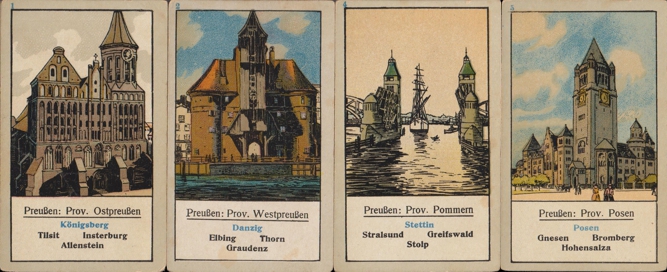
Quartets
Selection of beautifully illustrated decks.
Culture [31] | Swiss topics [13] | Photographic quartets [4]
Selection of beautifully illustrated decks.
Culture [31] | Swiss topics [13] | Photographic quartets [4]










Gambling games
Casino and other gambling games.
Roulette [7] | "Vingt-et-un" [3] | Tombola/Bingo, Lotto [5]
Casino and other gambling games.
Roulette [7] | "Vingt-et-un" [3] | Tombola/Bingo, Lotto [5]









TIMELINE:
01.06.2024 — After revision, the new version is online, entirely in English.
22.02.2023 — Reached 2500 catalogued decks.
18.07.2022 — The site is transferred to a new server.
01.07.2021 — After around two years of preparation, the catalogue (Italian language version) is online.
01.06.2024 — After revision, the new version is online, entirely in English.
22.02.2023 — Reached 2500 catalogued decks.
18.07.2022 — The site is transferred to a new server.
01.07.2021 — After around two years of preparation, the catalogue (Italian language version) is online.
It should be noted that: a) all scans are taken from owned specimens; b) the images report the actual state of preservation (no retouching); to avoid any possible abuse: c) the resolution of the images has been limited; and d) complete decks are never represented; e) the information contained herein is subject to change and evolution, and is not binding. ‖ Those wishing to provide significant missing decks may contact: info [@] cedig.org. ‖ This site is the property of the «Centro di Documentazione e Informazione sui Giochi da tavolo» (CeDIG.org), Switzerland. All rights reserved. No part may be reproduced without permission.

